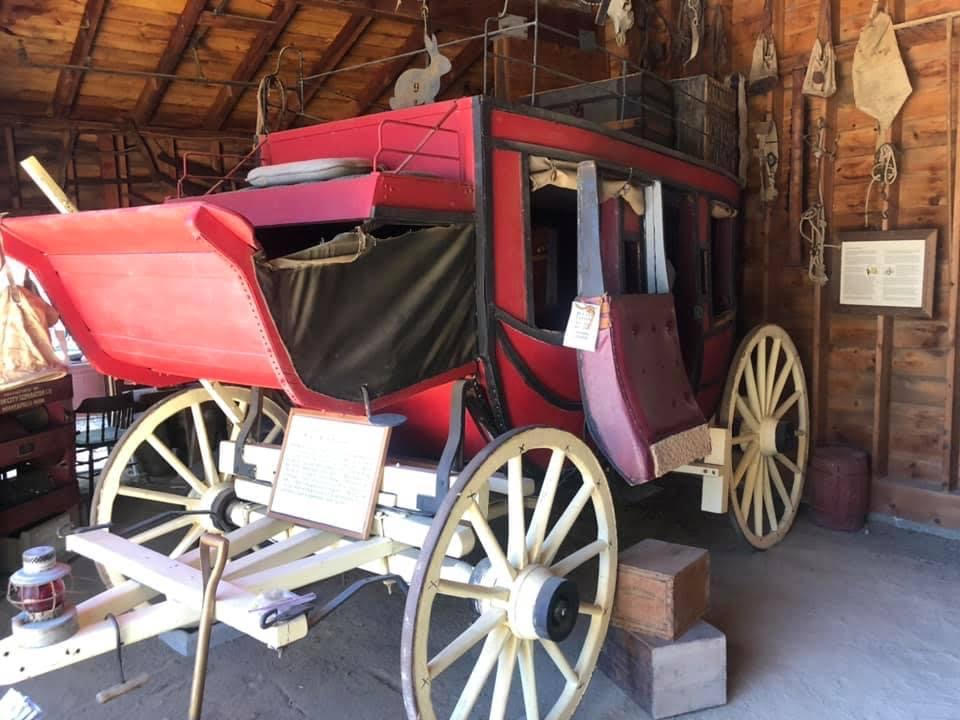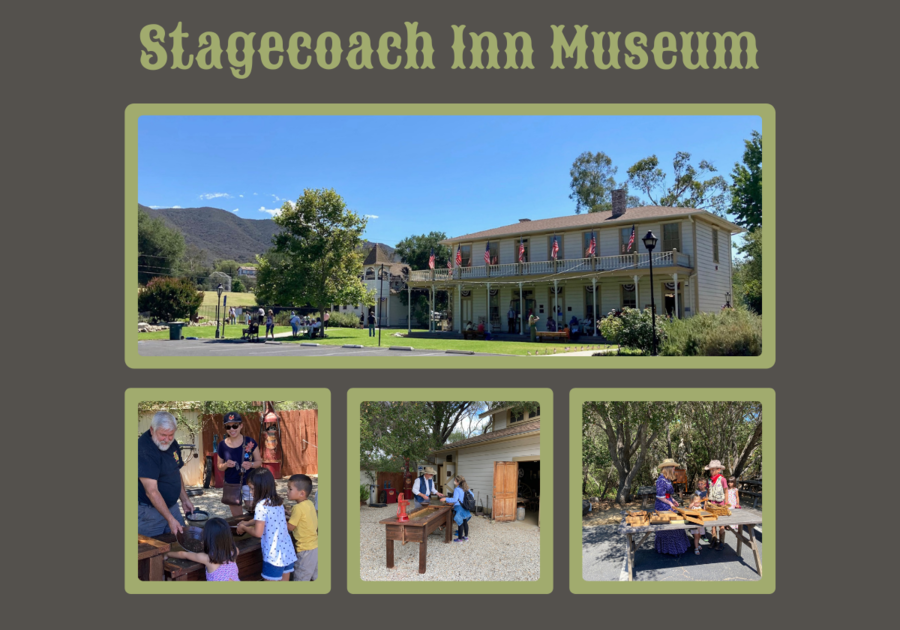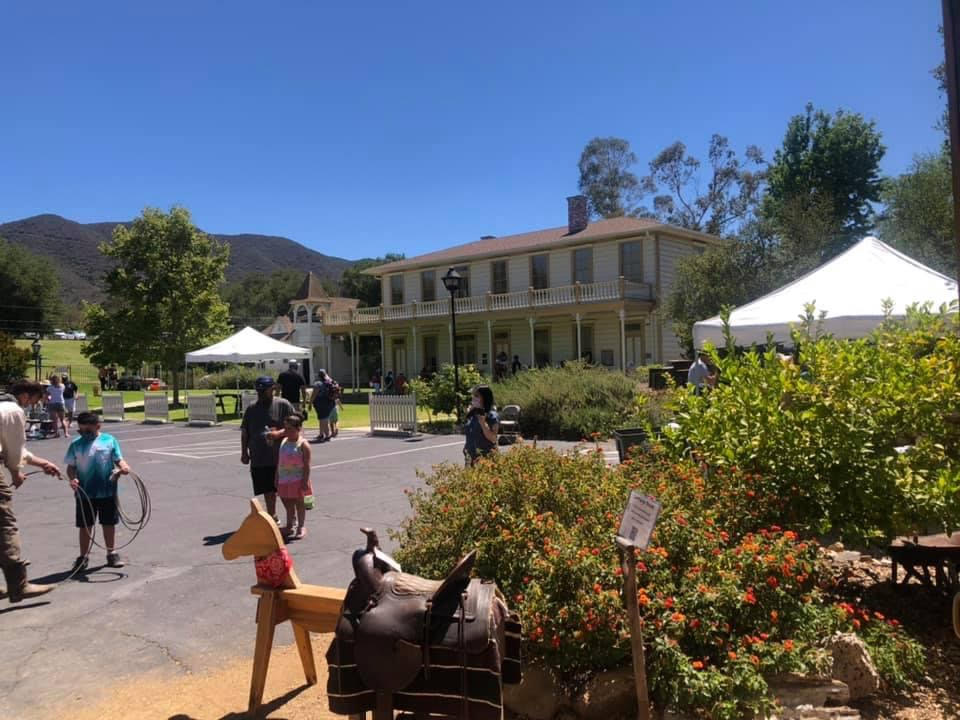Enjoy a family fun-time at the Stagecoach Inn Museum in Newbury Park, CA. From celebrating the season and special holidays to events and more you will have a Family fun time in the Conejo Valley. Enjoy ongoing activities like seasonal scavenger hunts, changing every few months with new hand-crafted metal art, enjoy the beauty of the heritage vintage rose garden, take a hike and explore the museum complex. Enjoy boutique exhibits and activities at the INN in the Conejo Valley. Learn about opportunities to volunteer.
Upcoming Events:
- December 6, 7 & 8: 🎄🕎 Home for the Holidays
Exhibits at the INN:
- A Wrinkle in Time – History of Washing & Ironing
- Jungleland
- Hair Jewelry - The Curious Art of Hairwork
- Crank up the Music - Crank up the Music – Showcasing over 30 early music machines
About the Stagecoach Inn Museum:
The Stagecoach Inn Museum complex in Newbury Park is a fantastic place for the whole family to enjoy. Explore a nature trail where you can step back into time in the beautifully decorated INN and historical replica buildings representing Conejo Valley History. Bring your children and try gold panning while listening to live music on the Grand Porch! Experience what life was like in the early days of the Conejo Valley with costumed docents guiding you through history and highlighting special items and antiques.
You will appreciate the beautiful five-acre property, designated by the City of Thousand Oaks as Historical Landmark No. 1, built in 1876 as the Grand Union Hotel, the Stagecoach Inn Museum Complex boasts an 1870s one-room schoolhouse "Timber School," Carriage House and stagecoaches, working Blacksmith Shop - on most Saturdays, Pioneer Home, California Adobe, indoor Chumash Exhibit and outdoor Village, Heritage Rose Garden, Heritage Oak Patio, Farm Trail, and for those with a sense of adventure the Nature Trail. Several exhibits are augmented with QR code signage, offering “Virtual Tour” video enhancements via your smartphone.
Museum Happenings:
Ongoing:
- Live Music most Wednesdays and Saturdays by local artists
- Seasonal Scavenger Hunts: changing hunt every few months with new hand-crafted metal art
- Shop our Boutique
- Volunteer Opportunities
Exhibits and Activities
A Wrinkle in Time:
Washing, drying, starching, ironing, mending - caring for our clothes once took two full days of back-breaking labor every week. What motivated women to tackle “the herculean task which all women dread”, even in the most exhausting conditions?
With antique irons and laundry tools galore, this hands-on exhibit invites you to explore "women's work" and social hierarchies, patents and the age of electricity, and the development of household technology.
“Washed and put out the white clothes but it rained, and I hung the colored ones in the house.” -Mary Jane Hunt, Newbury Park pioneer whose diary carefully notes on every Monday in 1896 whether or not she did the laundry that day
By the mid-1800s, most white women in the United States could read and write. The plethora of domestic advice manuals sought to teach moral values through good housekeeping; an untidy home led to frequenting the saloons.
Housewives were advised to keep to a strict weekly schedule for their chores:
Wash on Monday, iron on Tuesday, mend on Wednesday, churn on Thursday, clean on Friday, bake on Saturday.
With no ready-made laundry products on store shelves, women had to know how to make their own recipes for cleaners and starches using ingredients such as saltpeter, borax, vinegar, eggshells, baking soda, lemon juice, ammonia, beef’s gall. Fabrics and dyes of the period necessitated a different recipe for each fabric and stain.
Housewifery was terribly hard and demoralizing work. Authors of domestic manuals tried to provide a road map for new brides and buck up their spirits. Miss Catherine Beecher wrote in 1848: “The number of young women whose health is crushed, ere the first few years of married life are past, would seem incredible to one who has not investigated this subject…”
Jungleland
You will see diverse memorabilia from the Conejo Valley’s beloved animal farm and amusement park. Originally Goebel’s Lion Farm, then World Jungle Compound, and finally Jungleland, it was one of Southern California’s most popular tourist spots for over forty years
There was a time when residents of the Conejo Valley weren't surprised to see an elephant walking down the street, lions sunning themselves in a parking lot, or a hippo accompanying his two-legged buddy into a bar. Back in the day, Thousand Oaks was home to not only the Jungleland wild animal park (sited where the Civic Arts Plaza now stands) and its performers, trainers and staff, but also to circuses that over-wintered in the area, animal trainers who supplied beasts of all stripes to the television and movie industry, as well as the attendant veterinarians and other folks employed to care for the animals.
Hair Jewelry - The Curious Art of Hairwork
Carmelita Johnson’s love affair with hairwork began in 1968. A portion of Carmelita's collection resides at the Stagecoach Inn Museum; the rest is at the Fashion Institute of Design and Merchandising Museum in Los Angeles. Carmelita Johnson was one of the first persons to write a book exclusively about hair art and Mrs. Johnson amassed one of the largest collections of the unusual pieces in the United States.
During the 1850s in America, working hair into jewelry was a popular pastime. As a home craft, it was painstaking, often requiring more than 80 strands of hair for one piece of weaving material. In the display, is a hair shirt in the style of the time, a picture frame, love knots, and even a doll’s coat. Hair was fashioned into wreaths, pictures and jewelry by intricate twisting, braiding, weaving and made on tables just like lacemaking. When finished the pieces were used as memorials, to commemorate important events, as friendship and love tokens, or just for decorative purposes.
Godey’s Lady’s Book in 1860 pointed out “Hair is at once the most delicate and lasting of our materials and survives us like love.” And from another publication, “they are now almost as much worn by the ‘upper-ten’ as are golden ornaments; and that the effect—to say nothing of the pleasant ideal of thus wearing the hair of those we love and cherish—is incomparably superior to metallic jewelry, no person of good taste will venture to deny.” The fashion for all mourning jewelry came to an end at the turn of the twentieth century with the death of Queen Victoria, a change in mourning customs, and the beginning of World War I.
The Stagecoach Inn Museum upstairs display is a wonderful opportunity to see many pieces of hair jewelry crafted as early as the 1700s.
Crank up the Music
If you haven’t seen the Crank up the Music exhibit donated by past docent, Ken Kilbourn, showcasing early music machines, please come for a visit. There are more than 30 machines. The earliest ones have large spectacular amplifying horns, and the later ones have extraordinary cabinetry. The exhibit also includes fanciful advertising posters and needle boxes. There is a Victor-R machine made in 1902 known as “pre-dog” since it was marketed before the famous RCA dog, “Nipper” listening to “his master’s voice” with his head cocked toward a record player, is still instantly recognizable. The pictured ten-panel morning glory horn is hand-painted and red with bright bursts of yellow and blue flowers. There is an unusual all glass horn on exhibit and two oak horns.
Thomas Edison invented the phonograph in 1877. At the time, he was becoming hard of hearing and attempting to improve Alexander Graham Bell’s telephone with an amplified earphone. Edison coated a cylinder with tinfoil and pressed a needle against it. Sound vibrations from the telephone’s transmitter diaphragm caused the needle to etch a distinct line into the foil as the cylinder revolved. Kilbourne says even Edison was surprised to hear his words play back. There are two phonographs in the exhibit that you can listen to and compare with today’s recordings. Here is a trivia question: How many grooves are
 |
Ongoing Museum Activities
Live Music
Most Wednesdays and Saturdays during regular museum hours 1:00-4:00 pm on the Grand Porch and beyond. Relax and enjoy new and returning musicians each week, included with museum admission. You’ll want to return again and again to hear them all! Soak up the sounds of Steve Linsky, Allison Hawkins, Ruby Skye Music, Nostalgic Duo, Watermelon Pie, and more.
Shop at our Gift Emporium for historical books, unusual gifts, handcrafted and season themed items made by our docents including blacksmith forged horseshoe hearts, barn hooks and decorative yard ironwork items for every season. Check out our “Gold Miner’s Special” for kids’ gold panning activity. Give a gift that will last, buy a brick for the Heritage Rose Garden path and inscriptions will provide you, your family, and friends with a lifelong feeling of recognition and ownership. Paver bricks are perfect for birthdays, anniversaries, and memorials. Rose Garden Engraved Bricks — Stagecoach Inn Museum
 | Conejo & Critter Hunt
All the hunts feature Metal Art by our very own Blacksmith Bobby Mensinger of 4M Metalworks which is also available for purchase in our wonderful gift Emporium. |
Take a Hike on Our Very Own Nature Trail
The Museum’s five-acre site has more to explore than the Victorian interiors of the Stagecoach Inn. Next time you are hankerin’ for a breath of fresh air, come ramble over our trail system. The trails are all short but offer a pleasant change of pace for a lunch break, after-school visit, or an afternoon when you just gotta stretch your legs outdoors.
The “Runaway Stage Trail” serves up some elevation gain and goes above the tree canopy, offering views of Newbury Park, Thousand Oaks, and the surrounding hills. From the top you can see Tarantula Mountain in Thousand Oaks. The trail takes you to the edge of our property line, then drops down to Chumash Village. Detour to the left here, and you will find a 300-year-old sycamore tree.
The lower Nature Trail follows the creek bed under the oaks, crosses four bridges, and brings you to steps leading up to the Adobe. Look for the plant markers identifying vegetation native to the Conejo Valley.
For an easy stroll, walk along the Heritage Rose Garden and Farm Trails (suitable for little folks too). You’ll meander through Victorian roses and into an oak glade. Check out the antique farm equipment, and memorial bricks that honor museum volunteers and community leaders. There are benches and picnic tables for relaxing.
Take a stroll through the The Heritage Memorial Rose Garden located on property where you will find the many names of friends, families, and organizations whose donations and efforts have helped to preserve, maintain, and fund the many exhibits on the property.
Welcome to the memorable Stagecoach Inn Museum Heritage Memorial Rose Garden. The garden is located near the entry to the right. Entering this garden will literally take you down memory lane.
The Garden is filled with not only roses but many other colorful and fragrant flowers of all kinds.
The walkways of brick meander through the garden leading to a beautiful rose covered archway, where just beyond, sits a bench for resting and enjoying the splendor.
The walkway continues to grow each year, for it is truly a memory lane. As you look at the bricks you will see many fond memories of people, families, and even businesses, carved in stone for time everlasting.
The Ventura County Rose Society planted and maintains this garden. If you would like to request a memorial brick in the Heritage Memorial Rose Garden, please visit the Stagecoach Inn Museum. There is a donation fee that covers the purchase and installation of memorial bricks into the walkway.
The garden is located near the entry to the right. Entering this garden will literally take you down memory lane.
The Garden is filled with not only roses but many other colorful and fragrant flowers of all kinds.
The walkways of brick meander through the garden leading to a beautiful rose covered archway, where just beyond, sits a bench for resting and enjoying the splendor.
Stroll through the Gift Emporium
Shop at our Gift Emporium for historical books, unusual gifts, handcrafted and season themed items made by our docents including blacksmith forged horseshoe hearts, barn hooks and decorative yard ironwork items for every season. Check out our “Gold Miner’s Special” for kids’ gold panning activity. Give a gift that will last, buy a brick for the Heritage Rose Garden path and inscriptions will provide you, your family, and friends with a lifelong feeling of recognition and ownership. Paver bricks are perfect for birthdays, anniversaries, and memorials. Rose Garden Engraved Bricks — Stagecoach Inn Museum
Historical Landmarks Driving Tour of the Conejo Valley
Welcome to a fun and exciting way to visit the historical landmarks of Conejo Valley. In this tour, you will start at the Stagecoach Inn Museum, visit 16 historical sites and finish at the Pederson House on the California Lutheran University campus.
The historical landmarks included in this tour are: The Stagecoach Inn Museum, Sycamore Tree, Timber School, Hunt Olive Tree, Hillcrest Dr. Civic Center, The Janss House, Case Study House #28, Site of Jungleland, The Crowley House, Conejo School Monument, Lake Eleanor Dam, Westlake Historical Monument, Oakbrook Regional Park and Chumash Indian Museum, The Norwegian Grade, McCrea Ranch, and The Pederson House. Enjoy your trip through history
The original Stagecoach Inn: the Grand Union Hotel, was built in 1876 Located at the southwest corner of what is now Ventu Park Road and the 101-Ventura Freeway. It's designated as City of Thousand Oaks Landmark No. 1. |
General Information
Visitors welcomed every Wednesday and Saturday, 1:00-4:00 pm
Regular admission is $10 per person | $5 children 5 - 12 | Free for Children 4 and under and CVHS members
Annual CVHS Family Memberships may be purchased online or at the door for as little as $50
card, Apple Pay or exact cash please
Note: Not all buildings are open on Wednesdays; pricing may differ for dedicated events | Special tours and pricing are available upon request
Museum is Closed: Easter, Thanksgiving, Christmas and New Year's Day.
Dogs are not allowed on museum grounds or in the museum buildings - with the exception of service dogs.
 |
The Conejo Valley Historical Society
CVHS was formed in 1965 to save the original Grand Union Hotel from demolition, after which the Society developed a docent program and began leading tours of the Hotel - it was rebuilt in 1976 as the Stagecoach Inn. Fast forward to 2019, and the Stagecoach Inn Museum is a beloved member of the community, offering family-oriented special events, lectures, school programs, and a fun and friendly group of docents.
The Conejo Valley Historical Society is a non-profit 501(c)(3) entity registered with the State of California.
Their mission is to preserve, maintain, and exhibit an extensive historical record of the Conejo Valley and to educate the community about its cultural heritage.
Support the Stagecoach Inn Museum
- Become a member of the Conejo Valley Historical Society
- Make a donation
- Memorial Bricks
- Become a Volunteer
Volunteer Opportunities at The Stagecoach Inn Museum
- Want to learn more about Conejo Valley History?
- Got any time on your hands?
- Do you have experience fund raising? Writing grants?
- Do you like antiques?
- Are you creative?
We have a wide range of volunteer opportunities available now!! We are seeking help with fundraising ideas and Grant writing. In addition, we seek interested volunteers for giving Museum tours on Wednesdays and Saturdays, Wednesday morning School Children tours - 3rd through 5th grade, Special Request tours, Exhibit planning and set up, organizing, and planning Special Events, office assistance, gift emporium cashier, publicity efforts, recording oral histories and maintaining collections and archives. Also are opportunities to keep our grounds beautiful by donating time in our beautiful Heritage Rose Garden and grounds.
Volunteer and learn about the rich heritage of the area. We will explore local history by telling you the story of the Conejo Valley from the Chumash era to the present. You will appreciate the beautiful five-acre property, designated by the City of Thousand Oaks as Historical Landmark No. 1, built in 1876 as the Grand Union Hotel, the Stagecoach Inn Museum Complex boasts an 1870s one-room schoolhouse (Timber School), Carriage House (stagecoaches), working Blacksmith Shop (on most Saturdays), Pioneer Home, California Adobe, indoor Chumash Exhibit and outdoor Village, Heritage Rose Garden, Heritage Oak Patio, Farm Trail, and for those with a sense of adventure the Nature Trail.
If you are interested call 805-498-9441 or visit the Stagecoach Inn Museum website.
Check back for updates





